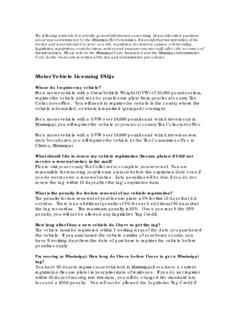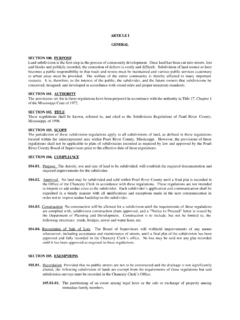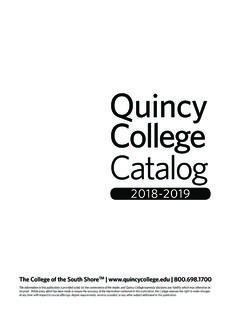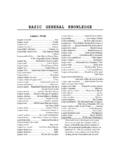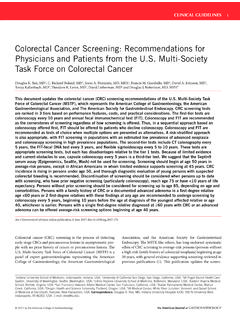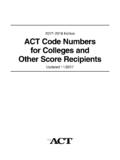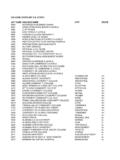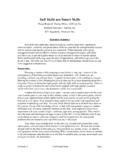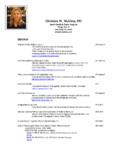Transcription of Section 1 Overview - Pearl River County, Mississippi
1 Section 1 Overview Land Use Planning in Pearl River County Pearl River County one of the fastest growing counties in Mississippi is at a critical stage of its history. With a rural landscape providing a quality of life and abundant natural resources, its residents are committed to maintaining the character and sense of place that have made this county home to generations and newcomers hoping to benefit from the amenities of country life and small town living. Even prior to Hurricane Katrina, Pearl River County was experiencing rapid development, spurred by inexpensive land, high quality of life, and proximity to major employment centers such as New Orleans, Gulfport and Biloxi. Located adjacent to the communities hardest hit by Hurricane Katrina, Pearl River County has also had a surge in population as Gulf Coast residents relocate.
2 Since Hurricane Katrina, growth rates have increased dramatically, with a increase in population projected by 2010. Critical land use decisions and development in the near future will shape the visual, physical, economic, and environmental character of the County for decades. This component of the Comprehensive Plan aims to help the County adapt to current and projected growth rates and to guide the next twenty to twenty-five years of growth. Strategically allocating resources and coordinating new development will enhance the economic, natural and cultural resources of Pearl River County. Purpose and Need Pearl River County has prepared this Land Use Plan with support from state grants to protect the quality of life for County residents, promote economic growth, and simultaneously guide development within the County in efficient ways to maintain a sense of place.
3 This document is a part of a comprehensive plan that includes plans for transportation, housing, community character and image, public infrastructure, and economic development. This document will continue to be revisited and the Land Use Plan is a living document that will continue to evolve Plan Overview The Land Use Plan that follows is intended to provide the roadmap for implementation of comprehensive plan related to land use, and contains the following sections; An review and analysis of existing conditions, including land use, population, housing, economy, the built environment, and the natural environment; A summary of recent growth trends and projections for population and build out to illustrate potential land use in the near future; A 1-1 Land Section 1 Overview A 1-2 Land Suggestions for implementing responsible growth management to preserve the county s rural atmosphere through growth and conservation corridors; Section 2 Existing Conditions Land Use Identifying and defining current land uses enables a municipality to assess its resources and assets as well as help define its future needs.
4 This Section provides an inventory of the existing land use pattern and distribution within Pearl River County. Land use delineation was created manually by examining post-Katrina aerial photography. Simplified land use categories were formulated and are explained in the table below: Land Use Category Land Use Description High Density Residential Residential areas with one or more units per acre. This includes townhomes, multi-family units, and single-family homes on lots smaller than 1 acre. Low Density Residential Large residential areas with fewer than one unit per acre. Rural Residential Residential low density areas with fewer than 10 contiguous dwelling units. Commercial/Industrial/Institutional Any non-residential built environment.
5 These parcels may be further delineated to show commercial, industrial and institutional land uses separately. Open Space Recreational open space or parks. Agricultural* Pasture, crop and small farmland. Forest Any land with forest or shrub cover as well as land that has been recently cleared but not yet developed. Infrastructure Roads and utility lines within a clear right of way. *Agricultural land use areas were determined by the extent of cleared land and the absence of additional housing units. Aerial photography was employed in order to create a comprehensive Land Use Map and data was consolidated into the consolidated into the eight categories above.
6 Pearl River County s approximate 810 square miles are characterized by different types of land uses, as displayed in the Existing Land Use Map below (Figure 21). The A 2-1 Land !(43!(43!(13!(26!(43 11!(43!(13 59 59!(53!(607!(43!(26 PicayunePoplarvilleLumbertonLegendHigh Density ResidentialLow Density ResidentialRural ResidentialCommercial/Industrial/Institu tionalInfrastructureOpen SpaceAgriculturalForestWaterSection 2 Existing Conditions majority of the County is covered by forest or used for agricultural purposes, totaling more than 87 percent of the land area. More than a quarter of the County s residents (or 13,136 individuals) are found in its two cities: Picayune and Poplarville, according to the 2000 Census. Poplarville is the county seat and home to Pearl River Community College.)))))))))))
7 The high density residential areas, those regions with more than one unit per acre, are concentrated within these two cities and along the Interstate 59 (I-59) and Hwy 11 corridor running from Poplarville south to the Mississippi /Louisiana border. These high-density neighborhoods are found in Picayune, Carrier, Poplarville, Nicholson and the Southeast. The Northeast, Steephollow, and Pine Grove neighborhoods are characterized as low-density. Low-density residential zones are areas with less than one unit per acre; they also tend to be concentrated along the major roadways: I-59, Hwy 11, State Highway 53 (MS 53) and State Highway 43 (MS 43). Rural residents, living in areas with less than 10 contiguous single-family residential lots, are found throughout the County.
8 However, Amackertown, Crossroads and the other northwestern areas of the county are nearly exclusively rural in their residential character, whereas the southcentral region of the county is much more heavily populated. Housing developments of all types account for nearly percent of the total land area. The land devoted to recreational open space or parks is a relatively small amount ( percent of total land acreage) and is found almost exclusively within the city limits of Picayune and Poplarville. The Pearl River , Wolf River , Hobolochitto Creek, as well as the lakes, rivers and tributaries that dot the county, make up less than 1 percent of the county s total area. Pearl River County s infrastructure is percent of the total acreage. The commercial, industrial and institutional areas, which include any non-residential development, make up just over 1 percent of the county s total land area.
9 These zones are found in pockets throughout the county but are concentrated in Picayune and Poplarville and along the Hwy 11 and I-59 transportation corridor. These areas consist of the commercial and retail establishments, as well as office parks, industrial parks, schools, hospitals, museums and public spaces. Pearl River County is overwhelmingly undeveloped. Nearly three-quarters of the county is open space, forest land or part of the waterway system. In fact, there is more land devoted to agriculture alone than to all types of residential neighborhoods and support services (roadways, schools, retail establishments, workplaces, etc.). The county s open space and sparse development is the foundation for the area s rural character. Population Demographics Pearl River County was home to 48,621 people in 2000 and the Census Bureau estimates that figure to have grown to 57,099 residents by mid-2006.
10 (In all cases, the A 2-3 Land Section 2 Existing Conditions most recent available Census data is used.) This represents a percent increase in the county s population, significantly greater than Mississippi s percent population increase during those years. From 2005 to mid-2006 more than 4,600 new residents moved to the county, signifying a nearly 9 percent jump in population in that year alone. During this time period, Pearl River County was the 6th fastest growing county in the country, according to the Census Bureau. Many residents from the coastal counties of Hancock, Harrison and Jackson were moving further inland, for these counties were among those with the fastest rate of population decline from 2005 to mid-2006. According to 2000 census figures, more than 70 percent of the population lives in rural unincorporated areas of the county.

